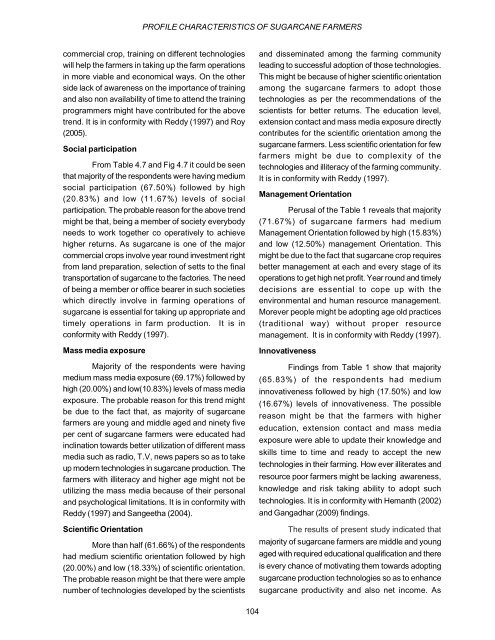The Journal of Research ANGRAU
Contents of 41(1) 2013 - acharya ng ranga agricultural university
Contents of 41(1) 2013 - acharya ng ranga agricultural university
You also want an ePaper? Increase the reach of your titles
YUMPU automatically turns print PDFs into web optimized ePapers that Google loves.
PROFILE CHARACTERISTICS OF SUGARCANE FARMERS<br />
commercial crop, training on different technologies<br />
will help the farmers in taking up the farm operations<br />
in more viable and economical ways. On the other<br />
side lack <strong>of</strong> awareness on the importance <strong>of</strong> training<br />
and also non availability <strong>of</strong> time to attend the training<br />
programmers might have contributed for the above<br />
trend. It is in conformity with Reddy (1997) and Roy<br />
(2005).<br />
Social participation<br />
From Table 4.7 and Fig 4.7 it could be seen<br />
that majority <strong>of</strong> the respondents were having medium<br />
social participation (67.50%) followed by high<br />
(20.83%) and low (11.67%) levels <strong>of</strong> social<br />
participation. <strong>The</strong> probable reason for the above trend<br />
might be that, being a member <strong>of</strong> society everybody<br />
needs to work together co operatively to achieve<br />
higher returns. As sugarcane is one <strong>of</strong> the major<br />
commercial crops involve year round investment right<br />
from land preparation, selection <strong>of</strong> setts to the final<br />
transportation <strong>of</strong> sugarcane to the factories. <strong>The</strong> need<br />
<strong>of</strong> being a member or <strong>of</strong>fice bearer in such societies<br />
which directly involve in farming operations <strong>of</strong><br />
sugarcane is essential for taking up appropriate and<br />
timely operations in farm production. It is in<br />
conformity with Reddy (1997).<br />
Mass media exposure<br />
Majority <strong>of</strong> the respondents were having<br />
medium mass media exposure (69.17%) followed by<br />
high (20.00%) and low(10.83%) levels <strong>of</strong> mass media<br />
exposure. <strong>The</strong> probable reason for this trend might<br />
be due to the fact that, as majority <strong>of</strong> sugarcane<br />
farmers are young and middle aged and ninety five<br />
per cent <strong>of</strong> sugarcane farmers were educated had<br />
inclination towards better utilization <strong>of</strong> different mass<br />
media such as radio, T.V, news papers so as to take<br />
up modern technologies in sugarcane production. <strong>The</strong><br />
farmers with illiteracy and higher age might not be<br />
utilizing the mass media because <strong>of</strong> their personal<br />
and psychological limitations. It is in conformity with<br />
Reddy (1997) and Sangeetha (2004).<br />
Scientific Orientation<br />
More than half (61.66%) <strong>of</strong> the respondents<br />
had medium scientific orientation followed by high<br />
(20.00%) and low (18.33%) <strong>of</strong> scientific orientation.<br />
<strong>The</strong> probable reason might be that there were ample<br />
number <strong>of</strong> technologies developed by the scientists<br />
and disseminated among the farming community<br />
leading to successful adoption <strong>of</strong> those technologies.<br />
This might be because <strong>of</strong> higher scientific orientation<br />
among the sugarcane farmers to adopt those<br />
technologies as per the recommendations <strong>of</strong> the<br />
scientists for better returns. <strong>The</strong> education level,<br />
extension contact and mass media exposure directly<br />
contributes for the scientific orientation among the<br />
sugarcane farmers. Less scientific orientation for few<br />
farmers might be due to complexity <strong>of</strong> the<br />
technologies and illiteracy <strong>of</strong> the farming community.<br />
It is in conformity with Reddy (1997).<br />
Management Orientation<br />
Perusal <strong>of</strong> the Table 1 reveals that majority<br />
(71.67%) <strong>of</strong> sugarcane farmers had medium<br />
Management Orientation followed by high (15.83%)<br />
and low (12.50%) management Orientation. This<br />
might be due to the fact that sugarcane crop requires<br />
better management at each and every stage <strong>of</strong> its<br />
operations to get high net pr<strong>of</strong>it. Year round and timely<br />
decisions are essential to cope up with the<br />
environmental and human resource management.<br />
Morever people might be adopting age old practices<br />
(traditional way) without proper resource<br />
management. It is in conformity with Reddy (1997).<br />
Innovativeness<br />
Findings from Table 1 show that majority<br />
(65.83%) <strong>of</strong> the respondents had medium<br />
innovativeness followed by high (17.50%) and low<br />
(16.67%) levels <strong>of</strong> innovativeness. <strong>The</strong> possible<br />
reason might be that the farmers with higher<br />
education, extension contact and mass media<br />
exposure were able to update their knowledge and<br />
skills time to time and ready to accept the new<br />
technologies in their farming. How ever illiterates and<br />
resource poor farmers might be lacking awareness,<br />
knowledge and risk taking ability to adopt such<br />
technologies. It is in conformity with Hemanth (2002)<br />
and Gangadhar (2009) findings.<br />
<strong>The</strong> results <strong>of</strong> present study indicated that<br />
majority <strong>of</strong> sugarcane farmers are middle and young<br />
aged with required educational qualification and there<br />
is every chance <strong>of</strong> motivating them towards adopting<br />
sugarcane production technologies so as to enhance<br />
sugarcane productivity and also net income. As<br />
104

















